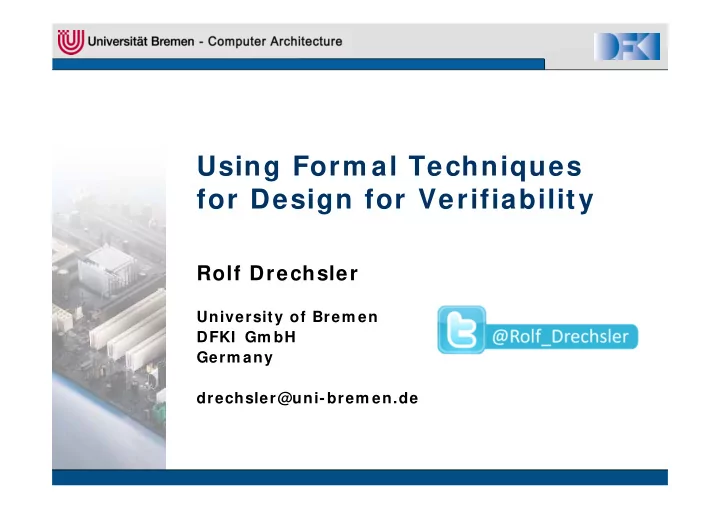

Using Form al Techniques for Design for Verifiability Rolf Drechsler University of Brem en DFKI Gm bH Germ any drechsler@uni-brem en.de
Verification • It is important – Trust me! • Very powerful tools in the market – Formal verification • For formal tools: little understanding of behavior 2
How does verification w ork? • Circuit is designed • Handed to verification tool – Simulation/ emulation – Formal techniques 3
How does verification w ork? • Circuit is designed • Handed to verification tool – Simulation/ emulation – Form al techniques 4
W hat w ould w e like to have? • Prediction – Run time – Memory requirement • Polynomial Questions: - Can this w ork for any/ all circuits? - How do these circuits look like? 5
Exam ple: m ultiplier verification • Formal Verification of Integer Multipliers by Combining Gröbner Basis with Logic Reduction (Sayed-Ahmed et al, DATE, 2016) – 128-bit multiplier verified • Polynomial verification of multipliers (Keim et al., Formal Methods in System Design, 2003) – Based on * BMDs (difficult DD type) 6
Design for verifiability • Goal: Design circuits such that – Formally verifiable – Polynomial bounds 7
Binary Decision Diagram s • Shannon decomposition: f f x f x f i x 0 i x 1 i i • Terminals: ‘0‘, ‘1‘ x i 0 1 • Ordered and reduced BDDs • Canonical data f x i =1 f x i =0 structure 8
Derive circuits from BDDs • Synthesis of fully testable circuits from BDDs (Drechsler et al, TCAD, 2004) • Each node is substituted by a multiplexor f ( x , x ) x x • Example: 1 2 1 2 X 1 t 0 1 X 2 1 MUX MUX X 2 X 2 MUX MUX X 1 X 1 0 1 9
Consider Construction • Small BDD does not imply small BDD during construction! – Otherwise: tautology checking would be trivial • But, interesting to look at BDD results : Bern et al: Global rebuilding of OBDDs Avoiding Memory Requirement Maxima. CAV 1995 10
W hat m akes verification hard? Fault site • Similar to test generation Justifi- • Circuit structure Propagation cation • Tree-like Reconvergent path -> polynomial verification (e.g. by BDDs) • But how about reconvergent paths? 11
Reverse engineer form al tools • E.g.: what makes SAT solvers efficient? – Implication graphs – Learning – Non-chronological backtracking – … • How do these circuits look like? 12
Conclusions • Today: very powerful formal verification tools – But: little understanding • Research goal: – Designing circuits that are by construction provably formally verifiable • Works for BDDs, but not trivial ! • Future work: extension to KFDDs, SAT, SMT,… 13
Using Form al Techniques for Design for Verifiability Rolf Drechsler University of Brem en DFKI Gm bH Germ any drechsler@uni-brem en.de
Recommend
More recommend